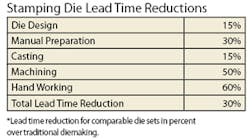Camito AB, Olofstrm, Sweden, recently signed a production order with SwePart Verktyg AB to produce 39 die shoes for metal stamping, in gray and ductile iron, for BMW. Production is underway at the new Camito Technology Center in Hstveda.
Camito received an order for 11 die shoes in March from SwePart, its first ever. SwePart Verktyg AB sells and manufactures stamping dies, and is one of three tool manufacturing companies in the Norwegian Bandak Group. The group has a production center and offices in Tyringe, Sweden, sales and projects offices in Bad Waldsee, Germany, and more production activity in Norway. Its tool manufacturing companies employ over 200.
Since March, Camito’s dedicated foundry has started production. On April 8, Camito reported a further order for three die shoes, to be produced using its patented technology. The process involves casting iron and steel together in the same mold, an approach that eliminates the need for insert assembly during die manufacture.
Camito is a subsidiary of Novacast Technologies AB (www.novacast.se), which develops and markets software for methods planning, simulation, and process control for the global automotive industry and its subcontractors, mainly foundries and tool manufacturers. It is widely recognized for its technique and equipment for the production of compacted graphite iron.
NovaCast was founded in 1981 by Rudolf Silln, who was a foundry manager for Volvo at Skvde, as well as at Kockums foundry in Kallinge, Sweden. He also served as manager for NovaCast during its early years until 1995, when Hans Svensson, now the majority shareholder, became Silln’s co-owner and partner.
NovaCast bought Camito in 2005, and has integrated its simulation software package into the software controlling the Camito process. Then, NovaCast acquired Swedish foundry Hstveda Gjuteri AB in 2006 to form the basis for the Camito Technology Center.
“Last fall we expanded our contacts to include die manufacturers,” reports NovaCast Technologies’ CEO Hans Svensson. “The cooperation with SwePart is the first visible example to prove the correctness of our strategy, and it is especially satisfying to reach a final customer such as BMW in this way.”
Recently, Camito president Christer Svensson pointed out that casting gray iron and tool steel in one mold reduces the lead times required to produce stamping dies, compared to the traditional approach of casting a gray iron base, into which are bolted machined tool-steel inserts.
In the Camito composite casting process, tool steel is cast onto the gray iron, after which the composite casting is ready for final machining. This approach reportedly is applicable to around 80% of all stamping die applications. The composite approach is important, Svensson said, because die lead times determine the time to market for “body-in-white” components, and any reduction in lead-time is an advantage to both the die maker and the customer.
For one, time-consuming manual fitting of machined die inserts is eliminated. For another, if finish machining is carried out with high-speed machining cutters, then hand finishing is virtually eliminated.
Svensson adds that the Camito technology offers several opportunities for reducing lead time (see table.) Other advantages include better tool-steel surface finishes, a lower coefficient of friction, and better hardenability when compared with stock-held tool steel products. Also, the Camito dies are repairable by welding and heat treating.
The Camito process also has been licensed to certified “partner” foundries, for which Novacast supplies suites of appropriate software (simulation, foundry engineering, and process control). Through its cooperation with SwePart, Camito expects to build up its order book and expand its contacts with other automotive groups. The cooperation adds another link to the Camito approach, through which collaboration already exists with Sandvik (machining) and Uddeholm (specialty materials).










